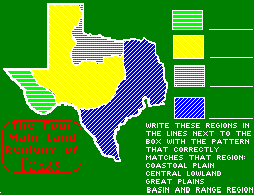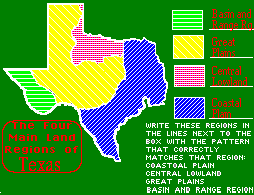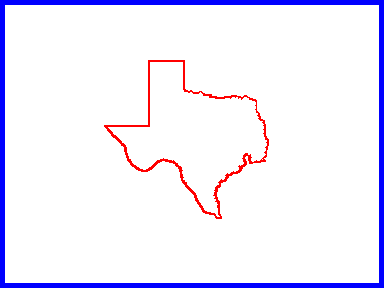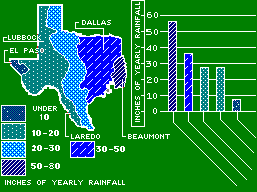Education samples: activity sheets

(All graphics ©Richard G. Mills 1996 All rights reserved.)

Texas State History . . .
Use with the program: Texas -- The Lone Star State
Skill Boosters for Video 1, 7th-grade Level
== 1 ==
Texas: Geography and Climate
Name_____________________________________
The Four Land Regions of Texas
The Four Land Regions of Texas

3a. In which land region do you live?
b. Write two paragraphs about how this land region affects people and industry around you and how it affects you and your family.
c. Choose a different land region and write about how your life might be different if you lived there.
ANSWERS:
1.
2. Answers may vary, but the meaning of each region name should be explained.
3a-c. Answers will vary depending upon the land region in which the student lives.
== 2 ==
Texas: Geography and Climate
Name_____________________________________
Texas Terms
2. What is a plain?
3. What is climate?
4. What is the Coastal Plain?
5. What is the Central Lowland?
6. What are the Great Plains?
7. What is the Basin and Range Region?
8. What are natural resources?
9. What are minerals?
10. What is a derrick?
11. What is natural gas?
12. What is an ore?
13. What are uses for helium?
14. What are uses for sulfur?
15. What is a use in industry for salt?
ANSWERS:
(Answers may vary somewhat.)1. The top portion of Texas that protrudes up between New Mexico and Oklahoma
2. A large, treeless area of flat or gently rolling land
3. The usual type of weather a place has over the years
4. The eastern and southern portion of Texas
5. The central northern portion of Texas
6. The central portion of Texas, including much of the northern portion of the Pan Handle and stretching down to the Mexican border
7. The far western portion of Texas
8. Things and materials found in nature that are useful to people
9. Substances found in the earth (neither plant nor animal), especially those with special uses for people
10. The tower-like frame that supports drilling apparatus
11. A gas (as opposed to the liquid gasoline) found deep in the earth and used for fuel and in manufacturing
12. Rock found in the earth (in rivers, etc.) with enough metal in it to make it worth mining
13. To make toy balloons float, in rockets, in weather balloons, in welding
14. To make sulfuric acid, used to make other products, including fertilizers and medicines
15. To help make glass, soap, and paper
== 3 ==
Texas: Geography and Climate
Name_____________________________________
Geographical Texas
_______________
b. Texas is still the largest of the "contiguous" states. What does "contiguous" mean?
_________________________
2a. The Rio Grande separates Texas from the country __________________.

3a. The Pecos River enters Texas from the State of
______________________.
b. Draw as much of this state's border as space allows, and label it.
4a. Part of the Red River runs between Texas and the States
of ______________________ and ____________________.
b. Draw as much of these states' borders as space allows, and label them.
5a. Part of the Sabine River runs between Texas and the State
of _____________________.
b. Draw as much of this state's border as space allows, and label it.
6. Write two or three paragraphs about how Texas's neighbors have affected Texan history and how they still affect Texas today.
ANSWERS:
1a. 1959b. [Answers may vary:] Actually touching at the boundaries
2a. Mexico b. [The student should have drawn the Mexican border and labeled Mexico on the map.]
3a. New Mexico
b. [The student should have drawn the New Mexican border and labeled New Mexico on the map.]
4a. Oklahoma [and] Arkansas
b. [The student should have drawn the Oklahoma and Arkansas borders and labeled Oklahoma and Arkansas on the map.]
5a. Louisiana
b. [The student should have drawn the Mexican border and labeled Mexico on the map.]
6. [Answers will vary but should include the effects of both the past and present.]
== 4 ==
Texas: Geography and Climate
Name_____________________________________
Meteorological Texas

2-5. Do the same for each of the other four cities shown.
6a. Locate and label your town or city (or the one nearest you) on the map.
b. How much yearly rainfall does the map say your city gets?
c. Add your city to the bar graph.
7. Write two or three paragraphs about how the climate affects local industry and the rest of life in your area.
ANSWERS:
1-5. [From right to left:] El Paso; Laredo and Lubbock [either blank]; Dallas; Beaumont6. [Answers should agree with the student's city location.]
7. [Answers will vary and depend upon the student's area of Texas.]
== 5 ==
Texas: Geography and Climate
Name_____________________________________
Texas Flora and Fauna
________________________ ________________________
________________________ ________________________
Make scientific sketches (accurate drawings) of these flora and fauna (plants and animals). Then write a paragraph or two describing in detail each plant and animal and its usual habitat. Conclude with a paragraph or two about why you think it is (or isn't) important to help preserve these unusual specimens of nature.
ANSWERS:
[Answers may vary [choices here]. The student should have made "scientific" sketches or drawings of each plant and animal, with brief descriptions of each one, including usual habitat. The written section should conclude with the student's own opinion of the importance of conservation.== 6 ==
Texas: Geography and Climate
Name_____________________________________
Texas Minerals
[ART: mineral map (was similar to ones above)]
2. Find where you live on the map. What mineral is found in or nearest your area? Write a short essay about how this mineral and its mining affects you and your family.
3. Write a short essay about how your area may be affected when this mineral is "mined out" (used up) in your area and what can be done now to prevent possible resulting problems.
ANSWERS:
- 1.
- G: Gas
- O: Oil
- S: Sulfur
- N: NaCl (Salt)
- H: Helium
- L: Limestone
- g: Gravel and Iron Ore
- C: Coal
- O: Oil
 Next
Next